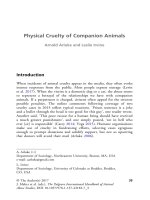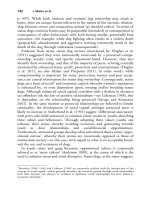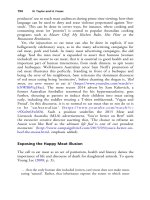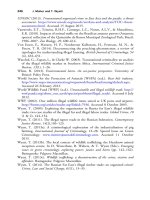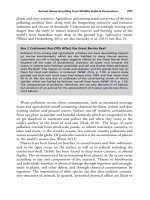The palgrave international handbook of a 261
Bạn đang xem bản rút gọn của tài liệu. Xem và tải ngay bản đầy đủ của tài liệu tại đây (33.98 KB, 1 trang )
Animal Abuse Resulting from Wildlife Habitat Destruction
257
plants and tiny creatures). Agriculture and mining stand out as two of the most
polluting activities here, along with the burgeoning extractive and resources
industries and the use of chemicals. Corporations are increasingly mining ever
deeper into the earth to extract mineral reserves and burying some of the
world’s most hazardous waste deep in the ground (e.g., radioactive waste)
(White and Heckenberg 2014; see also Stretesky et al. 2014) (see Box 2).
Box 2 Catchment Run-Offs Affect the Great Barrier Reef
Pollution from mining and agricultural activities can have devastating impacts
on marine environments, which are also habitats to many diverse species.
Catchment run-off is having major negative effects on the Great Barrier Reef,
situated off the coast of Queensland, Australia. As water runs towards the
ocean, it collects farm fertiliser, pesticides and soil and flushes these pollutants
onto the Reef: ‘The impact on corals and seagrass, and the species that rely on
them for food and shelter, is immense’ (WWF 2014, p. 119). A recent study
pointed out that reef coral cover had halved since 1985 and that more than
40 % of this loss was due to outbreaks of the coral-eating crown of thorns
starfish, which are fuelled by fertiliser run-off from farms (WWF 2014, p. 119).
The consequences of pollution, therefore, are not only demolition of habitat,
but provision of an avenue for the advancement of invasive species (see discussions below).
Water pollution occurs when contaminants, such as untreated sewerage
waste and agricultural runoff containing chemical fertilisers, poison and alter
existing surface and ground waters. Surface run-off transfers contaminants
from one place to another and harmful chemicals which are suspended in the
air get dissolved in rainwater and pollute the soil when they come to the
earth’s surface in the form of acid rain (Naik 2010). The scope of water
pollution extends from small-scale ponds, to inland waterways, estuaries, to
lakes and rivers, to the world’s oceans. Sea currents transfer pollutants and
wastes around the globe. Of particular concern is the accumulation of plastics
in the world’s oceans (see White 2013).
Plastics have been found on beaches, in coastal waters and their sediments,
and in the open ocean on the surface as well as in seabeds including the
continental shelf. Debris has been found in deep water canyons, at abyssal
depths. The environmental harm stemming from plastics in the ocean varies
according to size and composition of the material. Threats to biodiversity
and individuals manifest in physical damage through ingestion and entanglement in plastic and other debris, and through chemical contamination by
ingestion. The importation of alien species can also alter endemic community structures of animals. In general, ‘potential chemical effects are likely to
